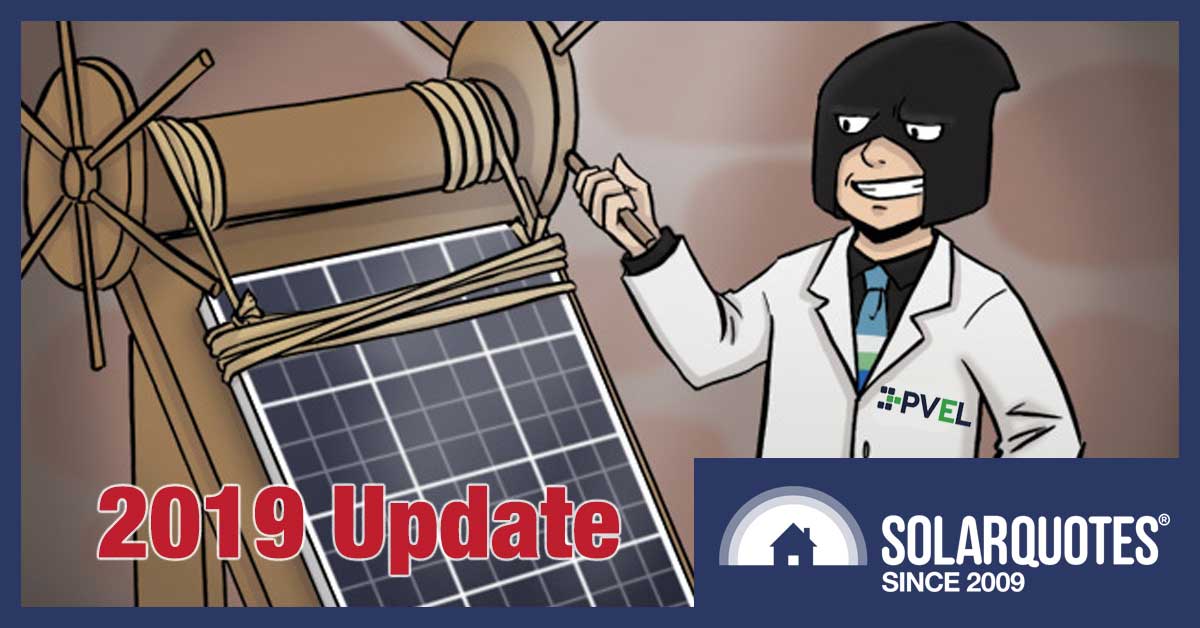
A new Module Reliability Scorecard was published earlier this month. It reveals the sadistic practices of a standards organization that subjected solar panels to torturous tests so they could announce which ones came out on top. But while it tells us who the winners are it doesn’t reveal which panels failed or degraded horribly. Despite not telling us which ones should be avoided, it still provides useful information.
Module Reliability Scorecards have been published since 2014. The testing format has varied but still shows a general improvement in the reliability of tested solar panels over time. But this wasn’t the case with one test this year. The Damp Heat test was worse. This is the fault of PERC panels. PERC solar panels, which are now very common, can suffer from a form of deterioration known as LeTID. LeTID is made worse by hot and humid conditions. Fortunately, PERC panels can be made resistant to this effect and such solar panels are included among the Top Performers for this test.
One interesting thing to note about this year’s Scorecard is the strong showing by Indian manufacturers. Two Indian companies — Adani/Mundra1 and Vikram — had solar panels that were classed as Top Performers.
Update 23rd June 2019: I originally called Boviet Solar an Indian company when Boviet2 is actually Chinese owned and manufactures in Vietnam. Sorry about that.
DVN GL Scorecards Now Done By PVEL
Module Reliability Scorecards used to be done by DNVGL — a large Norwegian standards company — but they are now done by PVEL. This is a smaller organisation that was gobbled up by DNVGL but has now been spat out as an independent lab. PVEL stands for PV Evolution Labs while DNVGL stands for some weird sounding combination of Norwegian and German.
Past Scorecards
You can check out what I’ve written about DVNGL’s scorecards over the past three years here:
Also, PVEL put out a solar inverter scorecard this year, but it focuses on North American inverters:
Scorecard Quotes
The scorecard spends a page or two gushing about how far solar has come and some of this gush is probably worth repeating:
“Since PV Evolution Labs (PVEL) was established in 2010… total installed photovoltaic (PV) capacity expanded tenfold to over 400 GW.”
“Total solar capacity is expected to reach 1 TW3 by 2023″
“In only 10 years, the average price of PV modules dropped by 90%”
But in other quotes PVEL cautions that:
“75% of the world’s installed solar PV capacity has operated for less than 5 years.”
“Long-term field data that proves today’s PV modules will perform reliably for decades does not exist.”
“Certifications and warranties cannot fully protect PV module buyers from field failures and subsequent financial consequences.”
They sure make it sound like we should pay attention to PVEL and their reports.
The Scorecard Routine
PVEL follows DVNGL’s usual method of presenting scorecard results. This consists of not telling us:
- Which panels performed poorly, or even…
- If a solar panel was tested at all.
They only tell us which solar panels did well on a test by suffering less than 2% reduction in performance. These are designated their Top Performers. We don’t even know which are the best out of this group as they are simply given in alphabetical order.
If you want detailed information you can pay PVEL for a detailed report, but I presume you’ll have to promise not to blab about the results all over the internet.
The Four PVEL Tests
PVEL subjected solar panels to 4 tests:
- Thermal Cycling: Determines the effects of temperature change.
- Damp Heat: How well a solar panel handles hot and humid environments.
- Dynamic Mechanical Load Sequence: How well they handle flexing from wind or snow.
- Potential Induced Degradation: How well they resist deterioration from stray currents.
Manufacturers have to pay for these tests and decide which types of panels they produce undergo which tests. What they can’t do is decide which specific panels get tested. PVEL is very careful to ensure only solar panels made for normal use are selected to prevent companies handing over high quality ring-ins.
Thermal Cycling Testing
Stuff expands when heated and contracts when cooled. Because this happens at different rates to different materials it puts stress and strain on joins and connections and can damage and break them. To test resistance to this, PVEL shoves panels into a combination freezer/oven, cools them down to -45 degrees, and then heats them up to 40 degrees. This is done 400 times over a month and a half.
It’s important for solar panels to do well on this test no matter where they are installed. But it is especially important for inland Australia where the temperature differential between day and night can be extreme.
Top Performers — those that suffered less than a 2% decline in output — are shown in this chart:
Of these 9 Top Runners, as far as I am aware, Boviet and Canadian Silfab panels are not sold in Australia.4
Damp Heat Testing
It gets hot here in Adelaide in the summer, but it’s a dry heat. Places like Darwin and Townsville have damp heat and nobody likes that. Not even solar panels. It’s the sort of environment that can cause the glue5 holding solar panels together to degrade and — in the case of the cheapest and shoddiest panels — can cause them to fall apart.
Provided you stay away from crappy solar panels you are not likely to get one that goes to pieces. But in PERC solar panels heat and humidity can cause a type of deterioration in called LeTID, which you can read about here. Because of this and because PERC panels are now so common, it has caused the average result on this test to go backwards instead of following the general trend of improving quality.
The good news is there are PERC panels that are resistant to this and some are included among the Top Performers:
Two of these Top Performers you are unlikely to see in Australia are the Indian made Adani/Mundra and Vikram panels.
Dynamic Mechanical Load Sequence Testing
Constant flexing isn’t good for you, which you’ll know if you spend an afternoon gardening. Continual flexing by wind isn’t good for solar panels and the Dynamic Mechanical Load Sequence tests how well they resist damage from this.
A good result on this test is a useful trait for a panel to have anywhere in Australia, but is obviously more useful in windy locations such as Newcastle and Toowoomba and less important in a place such as Adelaide, where the average wind speed is surprising low considering almost half the state’s electricity generation is from wind.
Top Performers that suffered less than 2% deterioration in performance were:
With Adani/Mundra and Vikram Solar listed above, Indian manufacturers have done well in this category. But any of these Top Performers would probably be a good choice if you are planning to use a solar panel as a wobble board.
Potential Induced Degradation Testing
Potential Induced Degradation, or PID for short, is caused by electrical currents going where they shouldn’t. In poorly made panels it can cause a rapid deterioration and eventually cause the entire solar panel to fail. It’s made worse by hot and humid environments making resistance to it is especially important in tropical Australia. Higher voltages also exacerbate it. Large commercial solar can have voltages higher than the residential limit of 600 volts, so PID resistance is an especially important consideration.
Fortunately, makers of quality solar panels have worked hard to eliminate or at least minimize this problem, so this test category has the most Top Performers and the average result is considerably better than in previous years:
Manufacturer Comparison
A Top Performer result is clear evidence a solar panel can handle a particular test with minimal deterioration. But because we don’t know if a panel was given a particular test or not, if it’s not listed as a Top Performer it doesn’t mean we can conclude it can’t meet that standard. This means we can’t conclude that any particular panel isn’t good. But just knowing which panels are definitely good is still useful.
If I take the 15 panel manufacturers that had a solar panel receive one or more Top Performer results I can separate them into 4 categories. These range from those that received a Top Performer result for a panel in every test to those that only received it for one test:
As the table shows, there were 3 manufacturers that got a Top Performer result for every test:
This doesn’t mean you can be certain every type of solar panel they sell will be awesome, but it is a good sign because it shows they at least know how to make durable solar panels that can pass those tests.
But don’t get too carried away by this table. For all we know ZNShine with its single Top Performer result only paid for one test and if their panels had received every test they would have got a Top Performer result for each. Also, there would be producers of high quality solar panels that didn’t bother to have any tested. This could be because they have their panels independently tested elsewhere, because they didn’t think the expense was worth it, or simply because they couldn’t afford to have their panels tested because they are going broke. The solar panel industry is extremely competitive, even for high quality manufacturers with excellent reputations.
Footnotes
- Australians mostly think of Adani as the Indian billionaire who wants to build a honking big coal mine in Queensland. It would be reasonable to assume Adani is a common name in India and the big coal hole Adani has nothing to do with the solar Adani, but actually hardly anyone in India has that name and it’s all the same dude. He is having what’s called a bet each way. ↩
- I didn’t like Boviet solar panels back when Balin was their CEO, but things improved under Brushchev. Later, CEO Borbachev reformed the company, but I’m not sure the current CEO, Butin, is taking things in the right direction. ↩
- A TW is a terrawatt, which is 1,000 gigawatts – close to 100 times as much solar power capacity as is currently installed in Australia. ↩
- We’re not likely to get Sifab panels here on account of Trump’s solar panel tariffs. These tariffs don’t involve us directly, but the whole world is affected by this very stable genius. ↩
- When it comes to solar panels the glue is often referred to as a polymer. This basically means it’s a plasticy type of glue. ↩
- With luck, this result will put an end to the rumour that GCL stands for “Glass Comes Loose”. ↩


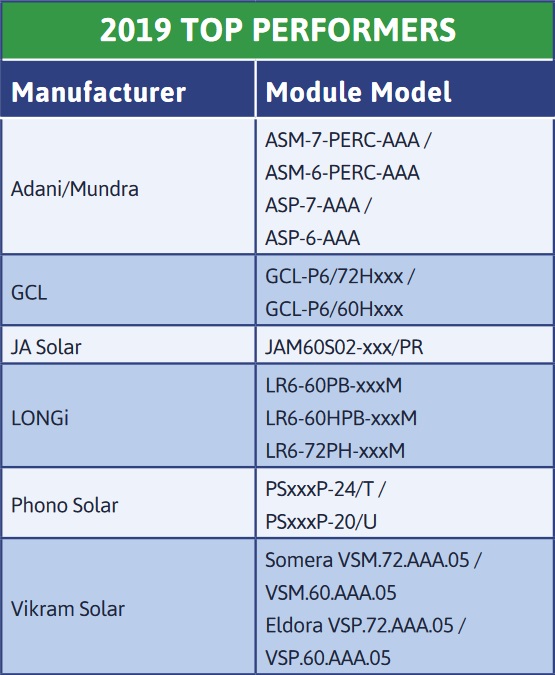
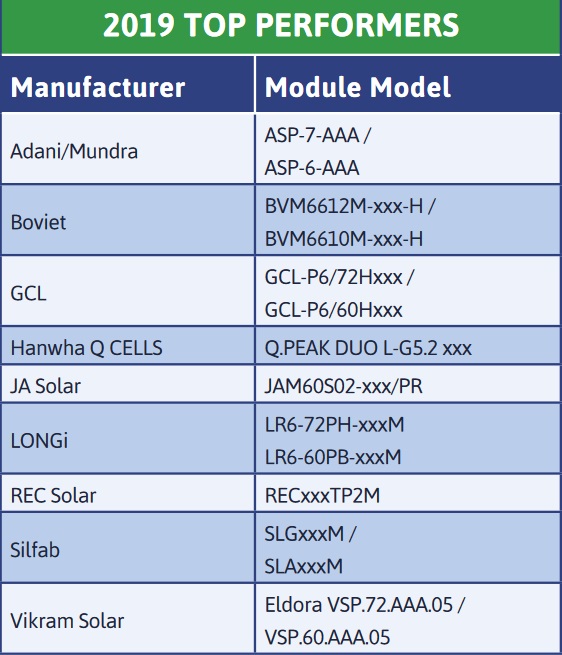
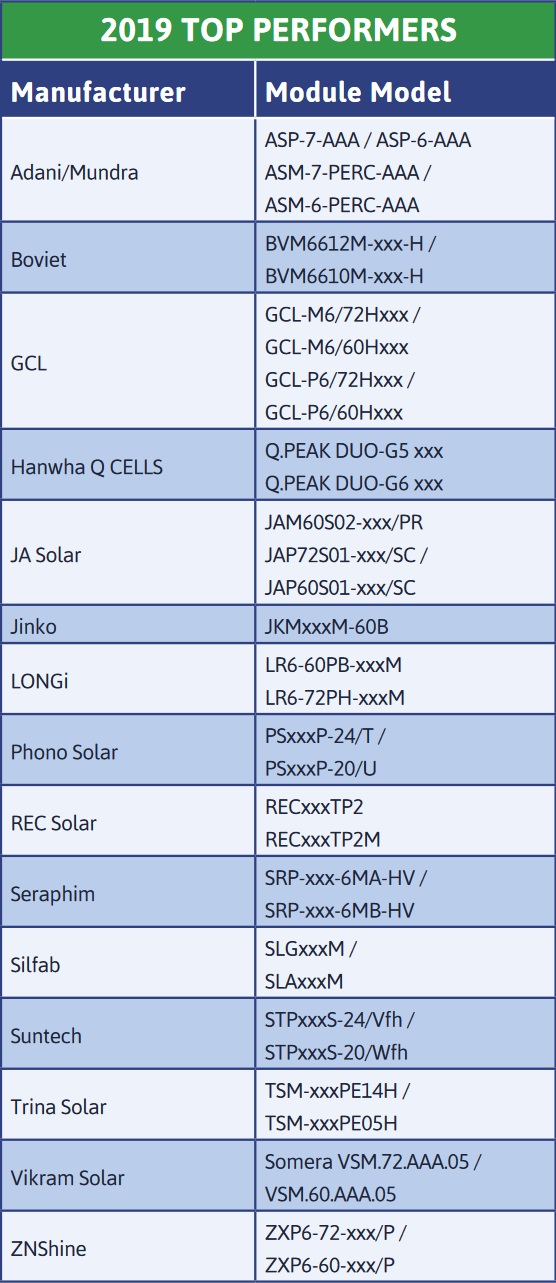
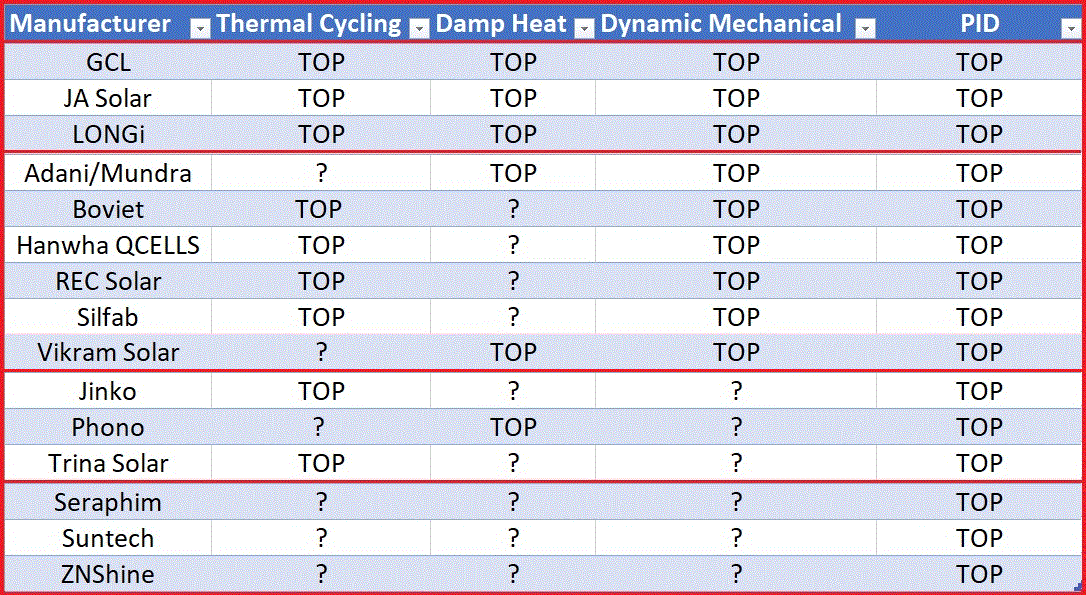
 RSS - Posts
RSS - Posts



Sunpower panels? Lg panels? Very confused why these are not on here?
There are only two things we can say. Either they were tested and didn’t get Top Performer status or they weren’t tested at all. With the information PVEL provides it’s impossible to say which. But we do have evidence they are good panels from other sources, so if anyone is thinking of getting those panels I don’t think there’s any cause to worry. (SunPower is having financial difficulty at the moment, but as SunPower panels are more reliable than average this is less of a concern than it would be for most panel manufacturers.)
James, Have a look at the panels tested at Desert Knowledge In the NT
http://dkasolarcentre.com.au/source/alice-springs/dka-m17-b-phase
Sunpower did not supply panel for 2019 as they received top performers in all 4 categories in 2018 and have not changed the panel so why pay to do the test again.
LG will have to answer why they are not having there panels tested, they have only ever had the MonoX in the test.
I was quoted JA’s JAM60S01/PR and was a little bit worried due to the perc type panel and letid degradation…
Now, these tests show three other JA models (JAM60S02/PR, JAP72S01/SC JAP60S01/SC) getting good results, especially JAM60S02/PR…
I guess JAM and JAP part of the model number means Mono or Poly Panels. 60/72 must be the number of cells in the panel and the “S” number could be the series/iteration no? so 2 follows 1…? the PR and SC part seems to signify whether the panel is percium or “legacy” (data sheet expression). Correct?
Could my quoted JAM60S01/PR’s be far behind JAM60S02/PR? As far as I understand, JA solar might not have submitted my panel for testing…
On the SQ comparison page (https://www.solarquotes.com.au/panels/comparison/compare-solar-panels/) only four models are listed under JA, none of the ones referred to in this article. The models are JAM S10, JAP S10, JAM S09 and JAP S09).
How do these relate to the test above? Looking at JA’s website, the s09 and s10 are their most recent panels. Wouldn’t it make sense for JA to submit those for testing rather than s01 and s02 panels..? I don’t understand…
Basically I’m looking for advise on whether to go with my quoted JAM60S01/PR panels, or ask for something else…
Looking at their datasheets I see your interpretation of the letters seems correct and I see that JAM60S01/PR and JAM60S02/PR panels that were a Top Performer in the Damp Heat test use the same percium solar cells. As LeTID occurs at the cell level both these panels should be equally resistant to it. So I think you can be confident the panels you have been quoted won’t suffer any significant amount of LeTID.
Hi Ronald
Thank you so much for your excellent reply. That puts my mind at ease.
Where does SolarEdge sit in the scheme of things with panels and Inverters?
SolarEdge provides a long 12 year warranty on their inverter. This does mean it costs more than the typical inverter with a 5 year warranty. Their inverter requires their optimisers to be placed on every panel. There have been issues with these optimisers failing, but they replace them under warranty. Hopefully they have gotten around to solving this problem.
Please update the Story. Boviet are Vietnamese panels and not indian hence the “Viet” in the name.
Oh dear. That’s a bad mistake. Normally when I do something like this I can see where I went wrong, but I can’t for the life of me think why I concluded Boviet was an Indian company. Thank you very much for pointing this out. I have updated the article.
And I was surprised at their good performance. I have links to Vietnam and all my Vietnamese friends can now be proud of this!!
solarI’m thinking of installing a jinko solar system.Can you give me some feed back on this system.
Hello David
Jinko Solar panels have a 10 year product warranty and a 25 year performance warranty. We consider them to be reliable and you are unlikely to have any problems with them. They are a lower cost panel and you can pay extra for better quality and a longer product warranty. Our Solar 101 Guide has a graphic which shows how all the panels we recommend compare on price:
https://www.solarquotes.com.au/solar101.html
Hi, have you heard of Canadian Solar, they use KuPower Panels. Can’t see any mention of them in your articles? Thanks in advance
Hi Davor
We definitely can recommend Canadian Solar panels. If you check out our Solar 101 guide we have a graphic that shows the panels we recommend and they are on it:
https://www.solarquotes.com.au/solar101.html
I’d call them a good combination of price and quality.
Thanks Ronald, they are using a panel called KuPower 300P, I can’t seem to find any info on them.
Here’s a link to the datasheet for them:
https://www.canadiansolar.com/upload/2c291770f7286dff/81fdc38f3810101c.pdf
That says they have a 10 year product warranty but Canadian Solar has told us they now offer a 12 year product warranty on all panels in Australia, so I would check you receive that.
Thanks so much for your reply, you guys are such a huge help. Kudos to you all..
Do you have anything to say about TÜV Rheinland’s “All Quality Matters” award? Are the products that are tested “gold plated” products, or are they ones that are independently sourced and that would actually be sold to customers?
I don’t have anything to say about the All Quality Matters awards at the moment, but Reneweconomy wrote about them in July:
https://reneweconomy.com.au/goodwe-wins-the-tuv-rheinland-all-quality-matters-award-5-years-in-a-row-96304/
From my article:
“Manufacturers have to pay for these tests and decide which types of panels they produce undergo which tests. What they can’t do is decide which specific panels get tested. PVEL is very careful to ensure only solar panels made for normal use are selected to prevent companies handing over high quality ring-ins.”